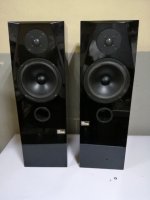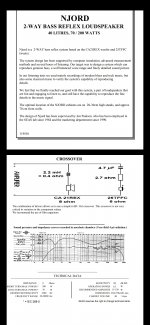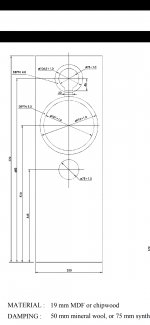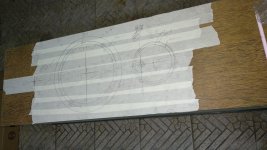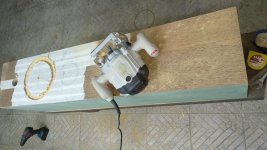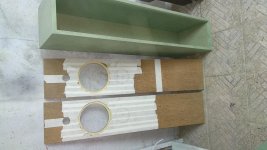They look interesting, quite a complex shape for a kit build.
I do not know what Seas kit they are, hopefully somebody else will come along who knows about them. You know the what the drivers are what do you want to find out?
You can try contacting seas if you don't get much feedback. Just wait a while longer to see what others have to say.
I do not know what Seas kit they are, hopefully somebody else will come along who knows about them. You know the what the drivers are what do you want to find out?
You can try contacting seas if you don't get much feedback. Just wait a while longer to see what others have to say.
Hi guys,
That is the Neon model, from the "Seas Sound" range of speaker kits of the late 80's. There's practically no info about it online, but it can be seen in this Norwegian ad from 1989. The 3-way Argon model, of which I own a pair, received an MkII update a couple of years later, where the H398 (25TAF/G) tweeter was replaced with H534 (25TAF/D). I assume the same update applied to the Neon and Helium models too.
The characteristic cabinet shape helps reduce baffle edge diffraction, and ready-made MDF cabinets for all models were available. Front covers were made from profile-cut foam, and usually attached with Velcro, but would sadly not last for long before starting to disintegrate. The woofer is mostly identical to the H296 (P21REX/DD), but equipped with a smaller dust cap made of soft PVC.
- H -
That is the Neon model, from the "Seas Sound" range of speaker kits of the late 80's. There's practically no info about it online, but it can be seen in this Norwegian ad from 1989. The 3-way Argon model, of which I own a pair, received an MkII update a couple of years later, where the H398 (25TAF/G) tweeter was replaced with H534 (25TAF/D). I assume the same update applied to the Neon and Helium models too.
The characteristic cabinet shape helps reduce baffle edge diffraction, and ready-made MDF cabinets for all models were available. Front covers were made from profile-cut foam, and usually attached with Velcro, but would sadly not last for long before starting to disintegrate. The woofer is mostly identical to the H296 (P21REX/DD), but equipped with a smaller dust cap made of soft PVC.
- H -
Last edited:
8inch with 25mm Tweeter used to be popular back in the day.
Here in Greece two of the most popular designers used to work with those drivers.
MTZ Audio - JAIRO speaker kit project
Also audio spectrum at their s37 speakers.
Another kit from seas is njord using similar drivers.
Here in Greece two of the most popular designers used to work with those drivers.
MTZ Audio - JAIRO speaker kit project
Also audio spectrum at their s37 speakers.
Another kit from seas is njord using similar drivers.
Attachments
As vassilus1984 said, these do have an uncanny resemblance to the old SEAS Njord kit:
Not the last word in sophistication, but you could probably find newer drivers that do much the same thing: SEAS: The Art Of Sound Perfection.
Hi guys,
The Neon and the Njord have obvious similarities, but the difference is in the details. I may be nitpicking, but hopefully all for the sake of nuance and clarity!

The "Seas Sound" range of speaker kits was developed in 1987/88, and consisted of three models: The bookshelf-sized (12 l) 6"+1" Helium, the floorstanding (I'm guessing 30-35 l) 8"+1" Neon, and the full-sized (70 l) 10"+3"+1" Argon. The idea behind these kits was to showcase Seas' latest technologies, and the floorstanders were fitted with the then-new aluminium dome H398 tweeter. The woofers were all polypropylene cones, and the smaller two had dust caps made of soft PVC for smoother response in the crossover region. The larger two were equipped with Seas' patented Dynamic Damping voice coils. Although I don't have the schematics, I suspect that the crossovers were at least 2nd order.
Ready-made cabinets were available for all three models, as Seas had a long tradition of cooperating with local furniture makers. These were made from 19mm MDF, and the characteristic bevelled baffles were a further development of a studio monitor design Seas did in the late 70s. Evershumi's speakers seems to have different bevel angles than the ones I've seen before (the original design had the bevels going very close to the tweeter), so they are probably DIY. MkII versions were fitted with improved H534 tweeters, which had a "diffuser" ring in front of the dome, instead of the mesh grid and phase disc of the earlier type. They also included bi-wiring terminals, bitumen pads on critical internal surfaces, and spikes for the floorstanders.
The "Seas Sound" branding was also used on the cardboard sleeve-covered polystyrene boxes, in which Seas drivers were shipped from the factory. The metal badges seen on the front of evershumi's speakers, however, only came with the kits. Here's a close-up of my own Argons:

The Embla and Njord models are much more recent than the speakers in question (the response measurements in the brochures are dated december '95). I actually built the Njord myself - or rather a smaller-box version of it - before starting my studies in the late 90's. Seas' product range had bifurcated by this time, with the introduction of the Excel-series of drivers in 1994/95. From that, the kit design philosophy also went in two different directions: The highly advanced and costly Excel-based kits (Odin, Froy, etc.), and the comparatively simplistic Embla and Njord kits based on affordable standard drivers. While the Embla is very similar to the Helium model in terms of size and driver technology, the Njord design represents a return to the "old-school" philosophy compared to the Neon. Gone is all the new-fangled stuff, and in comes the classic coated-paper 8" and fabric dome tweeter again.
To answer evershumi's last question:
Although data sheets for the H402 woofer aren't published, it should be reasonably close to the older H283/H296. If you want to run simulations in e.g. VituixCAD, you could use those parameters. My following suggestions would represent the edge cases, in terms of box size:
If you want to build a more compact enclosure for your Neon kit, placement close to the wall is probably needed, in order to compensate for the loss of LF response that goes with a smaller box. A sealed enclosure of 20 litres, with some stuffing, would be OK for this purpose.
If you want something bigger, with more low-end, the woofer should be able to cope well in reflex boxes of up to 50-60 litres, tuned to around 30 Hz.
- H -
The Neon and the Njord have obvious similarities, but the difference is in the details. I may be nitpicking, but hopefully all for the sake of nuance and clarity!
The "Seas Sound" range of speaker kits was developed in 1987/88, and consisted of three models: The bookshelf-sized (12 l) 6"+1" Helium, the floorstanding (I'm guessing 30-35 l) 8"+1" Neon, and the full-sized (70 l) 10"+3"+1" Argon. The idea behind these kits was to showcase Seas' latest technologies, and the floorstanders were fitted with the then-new aluminium dome H398 tweeter. The woofers were all polypropylene cones, and the smaller two had dust caps made of soft PVC for smoother response in the crossover region. The larger two were equipped with Seas' patented Dynamic Damping voice coils. Although I don't have the schematics, I suspect that the crossovers were at least 2nd order.
Ready-made cabinets were available for all three models, as Seas had a long tradition of cooperating with local furniture makers. These were made from 19mm MDF, and the characteristic bevelled baffles were a further development of a studio monitor design Seas did in the late 70s. Evershumi's speakers seems to have different bevel angles than the ones I've seen before (the original design had the bevels going very close to the tweeter), so they are probably DIY. MkII versions were fitted with improved H534 tweeters, which had a "diffuser" ring in front of the dome, instead of the mesh grid and phase disc of the earlier type. They also included bi-wiring terminals, bitumen pads on critical internal surfaces, and spikes for the floorstanders.
The "Seas Sound" branding was also used on the cardboard sleeve-covered polystyrene boxes, in which Seas drivers were shipped from the factory. The metal badges seen on the front of evershumi's speakers, however, only came with the kits. Here's a close-up of my own Argons:
The Embla and Njord models are much more recent than the speakers in question (the response measurements in the brochures are dated december '95). I actually built the Njord myself - or rather a smaller-box version of it - before starting my studies in the late 90's. Seas' product range had bifurcated by this time, with the introduction of the Excel-series of drivers in 1994/95. From that, the kit design philosophy also went in two different directions: The highly advanced and costly Excel-based kits (Odin, Froy, etc.), and the comparatively simplistic Embla and Njord kits based on affordable standard drivers. While the Embla is very similar to the Helium model in terms of size and driver technology, the Njord design represents a return to the "old-school" philosophy compared to the Neon. Gone is all the new-fangled stuff, and in comes the classic coated-paper 8" and fabric dome tweeter again.
To answer evershumi's last question:
Although data sheets for the H402 woofer aren't published, it should be reasonably close to the older H283/H296. If you want to run simulations in e.g. VituixCAD, you could use those parameters. My following suggestions would represent the edge cases, in terms of box size:
If you want to build a more compact enclosure for your Neon kit, placement close to the wall is probably needed, in order to compensate for the loss of LF response that goes with a smaller box. A sealed enclosure of 20 litres, with some stuffing, would be OK for this purpose.
If you want something bigger, with more low-end, the woofer should be able to cope well in reflex boxes of up to 50-60 litres, tuned to around 30 Hz.
- H -
Last edited:
That was fascinating, GeirH. Mange Takk, as you say.
There are several "Living Fossils" in the World.
Horseshoe crab - Wikipedia
Coelacanth - Wikipedia
Strangely, the good SEAS folks in Moss have knocked out another one: Seas P21RE/P H0942-08 Woofer. H0313 2015 remake
Strictly 30L closed box, IMO. But definitely polycone.
There are several "Living Fossils" in the World.
Horseshoe crab - Wikipedia
Coelacanth - Wikipedia
Strangely, the good SEAS folks in Moss have knocked out another one: Seas P21RE/P H0942-08 Woofer. H0313 2015 remake
Strictly 30L closed box, IMO. But definitely polycone.
Not so strange, really! 
As you know, by far, most of the production at Seas goes directly to loudspeaker manufacturers around the world. Their customers often want changes to be made to the drivers, with respect to the published standard line-up. The changes can be purely esthetic, such as a different colour or the inclusion of a logo onto the chassis, or more technical in nature, such as longer linear stroke or the addition of Faraday rings to the magnet pole. Sometimes the needs call for outright new designs, but it also happens that a customer may request remakes of older drivers. This is usually not a problem as long as the needed parts are still being made.
These "OEM" drivers are generally not available to others. From time to time, however, manufacturers go bankrupt, or shut down their speaker production for other reasons. Other times, a single speaker model may be discontinued. In any case, Falcon and others will often buy the driver inventories, and sell them to their own customers. If you search Falcon's "back catalogue" section, you'll find more examples of this.
The driver you mentioned is very likely the result of such circumstances. The letters "-OR" added to the model name (not mentioned by Falcon, but visible in the picture) is an abbreviated reference to the original customer. I haven't been able to figure out for sure who that is in this instance, but perhaps "O'Rourke" as in Ruark would fit the bill? Other known examples would be e.g. -AN (Audio Note), -APH (Audio Physic), -BS (Boothroyd/Stuart or Meridian), -GR (Gradient), -HB (Harbeth), -NAI (Naim), -SL (Linkwitz Labs), just to name a few.
- H -
As you know, by far, most of the production at Seas goes directly to loudspeaker manufacturers around the world. Their customers often want changes to be made to the drivers, with respect to the published standard line-up. The changes can be purely esthetic, such as a different colour or the inclusion of a logo onto the chassis, or more technical in nature, such as longer linear stroke or the addition of Faraday rings to the magnet pole. Sometimes the needs call for outright new designs, but it also happens that a customer may request remakes of older drivers. This is usually not a problem as long as the needed parts are still being made.
These "OEM" drivers are generally not available to others. From time to time, however, manufacturers go bankrupt, or shut down their speaker production for other reasons. Other times, a single speaker model may be discontinued. In any case, Falcon and others will often buy the driver inventories, and sell them to their own customers. If you search Falcon's "back catalogue" section, you'll find more examples of this.
The driver you mentioned is very likely the result of such circumstances. The letters "-OR" added to the model name (not mentioned by Falcon, but visible in the picture) is an abbreviated reference to the original customer. I haven't been able to figure out for sure who that is in this instance, but perhaps "O'Rourke" as in Ruark would fit the bill? Other known examples would be e.g. -AN (Audio Note), -APH (Audio Physic), -BS (Boothroyd/Stuart or Meridian), -GR (Gradient), -HB (Harbeth), -NAI (Naim), -SL (Linkwitz Labs), just to name a few.
- H -
Last edited:
To answer evershumi's last question:
Although data sheets for the H402 woofer aren't published, it should be reasonably close to the older H283/H296. If you want to run simulations in e.g. VituixCAD, you could use those parameters. My following suggestions would represent the edge cases, in terms of box size:
If you want to build a more compact enclosure for your Neon kit, placement close to the wall is probably needed, in order to compensate for the loss of LF response that goes with a smaller box. A sealed enclosure of 20 litres, with some stuffing, would be OK for this purpose.
If you want something bigger, with more low-end, the woofer should be able to cope well in reflex boxes of up to 50-60 litres, tuned to around 30 Hz.
- H -
Thanks for the sugestion.
I would like to build some larger columns 60 l 30Hz. does someone more knowledgeable have the availability to do a simulation for this speaker? thank you
Here's two sets of curves for you to compare. First, a 35 l / 30 Hz reflex box (although the Neons are probably tuned quite a bit higher):
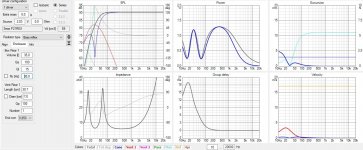
Then my 60 l / 30 Hz suggestion:
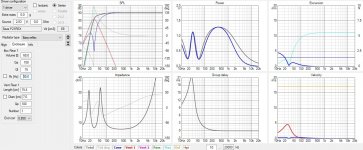
The port dimensions can be seen to the left of the curves. By increasing the box volume, the -3dB point has moved from above 45 Hz down into the low-30's. When increasing the signal to 100 dB SPL @ 1m (not shown), the 7 cm diameter port is still turbulence-free, and the woofer still close to its linear excursion range above the tuning frequency. There's still some headroom, but filtering out the extreme low-end (<30 Hz) may become necessary if you want to play very loud. After all, there are limits to what a single 8" can do.
Hope this helps!
- H -

Then my 60 l / 30 Hz suggestion:

The port dimensions can be seen to the left of the curves. By increasing the box volume, the -3dB point has moved from above 45 Hz down into the low-30's. When increasing the signal to 100 dB SPL @ 1m (not shown), the 7 cm diameter port is still turbulence-free, and the woofer still close to its linear excursion range above the tuning frequency. There's still some headroom, but filtering out the extreme low-end (<30 Hz) may become necessary if you want to play very loud. After all, there are limits to what a single 8" can do.
Hope this helps!
- H -
Last edited:
The simulations do not take vent placement into account. Aside from the main port resonance, the behaviour will depend on the internal damping, the exact dimensions of the box, etc. Port location will also determine its coupling to standing waves inside the box.
A front vent is often thought to make pipe resonances more noticeable, but I think the difference is small in practice. The same applies to downward ports, although may give more unpredictable results. In the latter case, you need floor clearance to avoid obstructing the vent, and a good rule-of-thumb is to keep it at least equal to the vent diameter.
I typically line the rear, sides, top and bottom with 1-2" foam or 2-4" fibreglass/mineral wool, depending on size and how much room that leaves inside. I always leave the baffle bare, and also make sure the inner opening of the vent is free.
A front vent is often thought to make pipe resonances more noticeable, but I think the difference is small in practice. The same applies to downward ports, although may give more unpredictable results. In the latter case, you need floor clearance to avoid obstructing the vent, and a good rule-of-thumb is to keep it at least equal to the vent diameter.
I typically line the rear, sides, top and bottom with 1-2" foam or 2-4" fibreglass/mineral wool, depending on size and how much room that leaves inside. I always leave the baffle bare, and also make sure the inner opening of the vent is free.
Last edited:
There's a nice calculator here, which allows you to find the standing wave frequencies of your proposed box. The ones determined by width and depth are going to be high enough in frequency, that they can be effectively dealt with by the lining/stuffing, especially immediately behind the woofer. The more problematic standing waves in a tall box like this are going to be those determined by its internal height, because these will be low enough in frequency that the lining/stuffing won't be very effective.
At 1 meter height, the first mode will be located around 170 Hz, the next one at twice that frequency, then three times the frequency, etc. You would ideally place both the woofer and the port where exitation is the least, but that point won't be the same for all standing waves. I'd suggest mounting both at ~1/4-length along the cabinet height, as that should at least reduce the first two modes.
Additionally, you can place a circumferential brace at the midpoint of the cabinet, and put a good amount of dense stuffing in the centre opening of the brace. Both the woofer and the port has to be mounted on the same side of this "subdivision", but this will reduce most of the height modes.
- H -
At 1 meter height, the first mode will be located around 170 Hz, the next one at twice that frequency, then three times the frequency, etc. You would ideally place both the woofer and the port where exitation is the least, but that point won't be the same for all standing waves. I'd suggest mounting both at ~1/4-length along the cabinet height, as that should at least reduce the first two modes.
Additionally, you can place a circumferential brace at the midpoint of the cabinet, and put a good amount of dense stuffing in the centre opening of the brace. Both the woofer and the port has to be mounted on the same side of this "subdivision", but this will reduce most of the height modes.
- H -
Last edited:
There aren't many tweeters that work well with simple crossovers.
Problem being the Fs resonance:
MOREL CAT 378 Soft Dome Horn Tweeter – AmpsLab
You can fix that with an LCR network.
If you want to have some interesting fun with another tweeter, I always have liked the look of this 104mm SEAS DXT one:
H1499-06 27TBCD/GB-DXT
My good friend Joachim Gerhard says it sounds good.
Problem being the Fs resonance:
MOREL CAT 378 Soft Dome Horn Tweeter – AmpsLab
You can fix that with an LCR network.
If you want to have some interesting fun with another tweeter, I always have liked the look of this 104mm SEAS DXT one:
H1499-06 27TBCD/GB-DXT
My good friend Joachim Gerhard says it sounds good.
Anecdotally there are better tweeters than SEAS ones, but I really don't know.
But have a look here for your woofer and think it might be similar to a CA21REX. About half-way down the page.
High Efficiency Speakers
Horrible crossover to build. But might repay. A 1kHz LCR notch on the woofer if I haven't lost my touch.
But have a look here for your woofer and think it might be similar to a CA21REX. About half-way down the page.
High Efficiency Speakers
Horrible crossover to build. But might repay. A 1kHz LCR notch on the woofer if I haven't lost my touch.
Last edited:
- Status
- This old topic is closed. If you want to reopen this topic, contact a moderator using the "Report Post" button.
- Home
- Loudspeakers
- Multi-Way
- Seas kit ??
